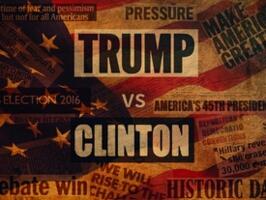This Race Is Down to the Debates
A Commentary By Fran Coombs
It’s hard to remember a time when the debates were so critical to the outcome of a presidential election.
Hillary Clinton and Donald Trump have each been hovering around the 40% level of support for weeks now in Rasmussen Reports’ weekly White House Watch survey. Factor in the survey’s +/- 3 margin of error, and it’s difficult to conclude anything except that this race is neck-and-neck.
Trump has taken the lead this week following questions about Clinton’s health and her “deplorable” comments about his voters, but unless it’s a trend in the making, this race could easily shift back her way a week from now.
A sizable number of voters continue to opt for third-party candidates Gary Johnson and Jill Stein or haven’t made up their minds. A diminishing number still plan on staying home rather than voting for the lesser of two evils.
Historically, however, that third-party support melts away as Election Day approaches because voters want their vote to count, and even now it’s not enough to put either Johnson or Stein in the debates. Only on very rare occasions do voters stick with their third-party choice to the bitter end, and there’s no question that Ross Perot was the one who put Bill Clinton in the White House in 1992.
(Want a free daily e-mail update? If it's in the news, it's in our polls). Rasmussen Reports updates are also available on Twitter or Facebook.
There’s also little doubt that both major party candidates are almost equally disliked and equally distrusted. On the major issues facing the nation, voter trust is just as closely divided.
This is a race in which George H.W. Bush, a former president and the patriarch of the Republicans’ First Family, is reportedly voting for the Democrat. But at the same time one-in-four Democrats disagree with the FBI’s decision not to seek a criminal indictment of their own nominee over her mishandling of classified information.
Clinton has been in the public eye for 25 years, so it’s difficult to imagine anything she will do or say at the debates that will come as a major surprise to a significant number of undecided voters. Trump, on the other hand, has the continuing ability to surprise, particularly if he continues to exercise the discipline and policy focus he has shown in recent days. But there’s also the other Trump who is just as likely to tee off on a TV talk show host or make some off-color reference that has his supporters cringing.
As Peggy Noonan and others have noted, Trump is the only one who can beat himself, and that, of course, is what the Clinton campaign is counting on. According to news reports, Clinton’s debate prep team is stocking up on things they hope will get under Trump’s skin and prompt the other Trump to emerge. A (relatively) disciplined Trump debate performance is a loss for Clinton’s side.
Meanwhile, the former first lady and secretary of State has performance issues of her own. Thin-skinned herself and nowhere near the retail politician her husband is, Clinton needs to temper her natural know-it-all wonkishness with more than a dollop of humanity. Ideally, she has to come across as a steady, purposeful contrast to the more mercurial Trump.
Perhaps most importantly, Clinton has to look healthy and alert. Perception is often reality in politics, and following her 9/11 health scare, voters will be watching closely for any signs of tiredness, any indication that her mind is wandering. After all, voters other than the Democratic faithful are wondering if she’s physically up to the job. We’ve all watched the presidency turn men’s hair gray, and no one wants to elect someone who doesn’t have the stamina for the position, particularly in such a demanding time. Presidents don’t get many weekends off to rest.
Trump’s issues – free trade, America First, a wall on the U.S.-Mexico border, a temporary halt to immigration from countries with a history of terrorism – are the defining issues of this race, and voters generally agree with him. Clinton appears to spend more time attacking those issues than advancing positions of her own. President Obama even took a swipe at the new nationalism Trump represents in his final major address to the United Nations this week.
Far less discussion has focused on Obama’s record over which Americans are strongly divided. Voters tend to see Clinton as a continuation of the president’s policies when it comes to national security, the economy and other major issues, and they’re not real happy about his performance in any of those areas. So other than whatever charisma buzz Obama still gives some voters, he’s not much help to his designated successor. Most voters definitely expect Trump to change things, but they’re not sure if it’ll be for the better or for the worse.
Then, of course, there’s the question of whether there’s a silent Trump vote out there that pollsters can’t find.
Given all this negativity and all these imponderables, a bang-up debate performance by one of the candidates seems essential. A clear winner will be on the path to take all. A draw will keep us guessing until Election Day.
Fran Coombs is the managing editor of Rasmussen Reports.
See Other Political Commentaries .
See Other Commentaries by Fran Coombs .
Views expressed in this column are those of the author, not those of Rasmussen Reports. Comments about this content should be directed to the author at fran.coombs@rasmussenreports.com.
Rasmussen Reports is a media company specializing in the collection, publication and distribution of public opinion information.
We conduct public opinion polls on a variety of topics to inform our audience on events in the news and other topics of interest. To ensure editorial control and independence, we pay for the polls ourselves and generate revenue through the sale of subscriptions, sponsorships, and advertising. Nightly polling on politics, business and lifestyle topics provides the content to update the Rasmussen Reports web site many times each day. If it's in the news, it's in our polls. Additionally, the data drives a daily update newsletter and various media outlets across the country.
Some information, including the Rasmussen Reports daily Presidential Tracking Poll and commentaries are available for free to the general public. Subscriptions are available for $4.95 a month or 34.95 a year that provide subscribers with exclusive access to more than 20 stories per week on upcoming elections, consumer confidence, and issues that affect us all. For those who are really into the numbers, Platinum Members can review demographic crosstabs and a full history of our data.
To learn more about our methodology, click here.



